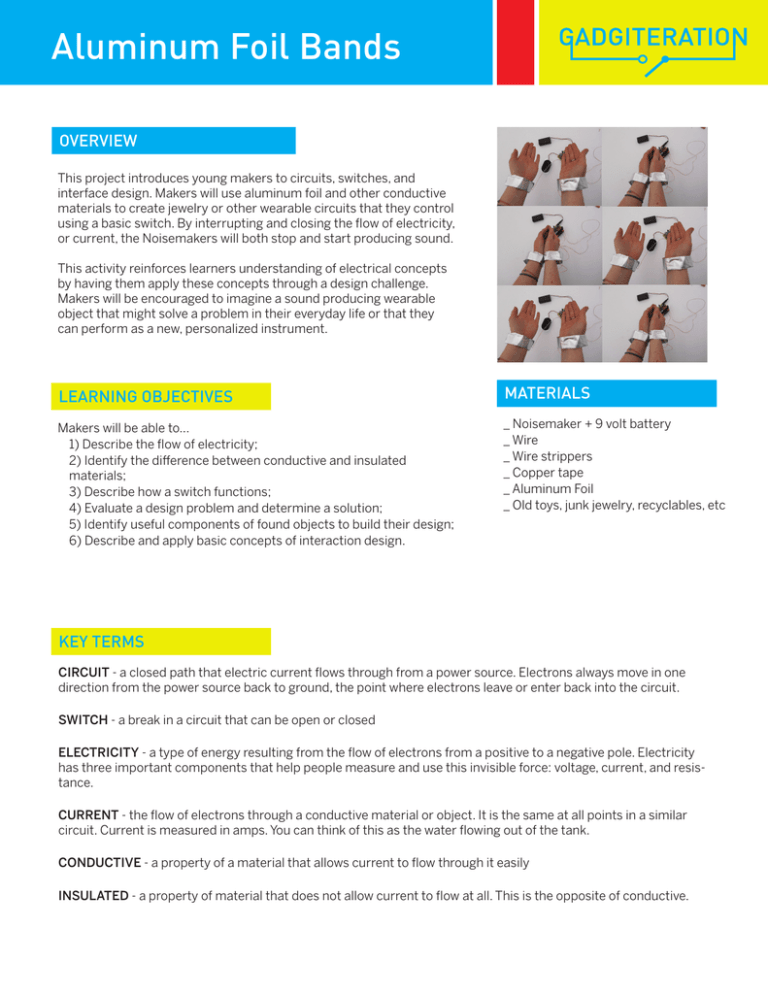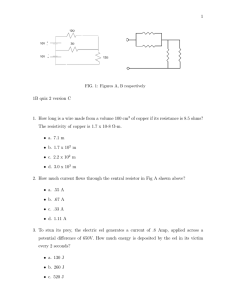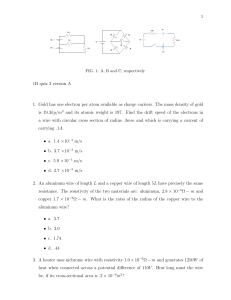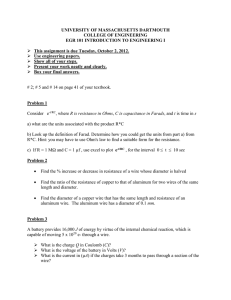Aluminum Foil Bands
advertisement

Aluminum Foil Bands OVERVIEW This project introduces young makers to circuits, switches, and interface design. Makers will use aluminum foil and other conductive materials to create jewelry or other wearable circuits that they control using a basic switch. By interrupting and closing the flow of electricity, or current, the Noisemakers will both stop and start producing sound. This activity reinforces learners understanding of electrical concepts by having them apply these concepts through a design challenge. Makers will be encouraged to imagine a sound producing wearable object that might solve a problem in their everyday life or that they can perform as a new, personalized instrument. LEARNING OBJECTIVES MATERIALS Makers will be able to... 1) Describe the flow of electricity; 2) Identify the difference between conductive and insulated materials; 3) Describe how a switch functions; 4) Evaluate a design problem and determine a solution; 5) Identify useful components of found objects to build their design; 6) Describe and apply basic concepts of interaction design. _ Noisemaker + 9 volt battery _ Wire _ Wire strippers _ Copper tape _ Aluminum Foil _ Old toys, junk jewelry, recyclables, etc KEY TERMS CIRCUIT - a closed path that electric current flows through from a power source. Electrons always move in one direction from the power source back to ground, the point where electrons leave or enter back into the circuit. SWITCH - a break in a circuit that can be open or closed ELECTRICITY - a type of energy resulting from the flow of electrons from a positive to a negative pole. Electricity has three important components that help people measure and use this invisible force: voltage, current, and resistance. CURRENT - the flow of electrons through a conductive material or object. It is the same at all points in a similar circuit. Current is measured in amps. You can think of this as the water flowing out of the tank. CONDUCTIVE - a property of a material that allows current to flow through it easily INSULATED - a property of material that does not allow current to flow at all. This is the opposite of conductive. Aluminum Foil Bands RESISTANCE - limits or resists the amount of current that can flow through a circuit. Resistance is measured in ohms. You can think of this as the size of the whole the water flows out of. The smaller the hole, the less water comes out. Likewise, more resistance limits the flow of current. VOLTAGE - electrical pressure that causes electricity to flow. It is measured in volts. You can think of this as the height of the water tank. There are 2 types: direct current (a battery) and alternating current (electricity from the wall). We are using direct current from a battery - DO NOT try these projects with alternating current from the wall. BATTERY - one or more cells that convert chemical energy into electrical energy. Chemicals in the battery free electrons so they can move from one terminal to the other. This movement creates electrical energy that you can use to power the electronics you use every day. POLARITY - in a circuit electrons move in one direction from the positive pole (power) to the negative pole (ground). When constructing a circuit, all components must be aligned properly so electricity can move through them. SHORT CIRCUIT - a direct connection between two sides of a power source. A short circuit can destroy your circuit and the components in it. Most importantly, this can be dangerous with high voltages, especially with electricity from the wall, and can electrocute or burn you. CURRICULUM CONNECTIONS Electricity How does a circuit transfer energy? What type of energy runs through a circuit? Where does energy change form in this project? What form does it change to? What is electricity? What are the fundamental concepts of electricity? How can we measure electricity? What is voltage, current, and resistance? What is the basic relationship between them? How is energy transferred in a circuit? NYS STANDARDS STANDARD 4—The Physical Setting Students will understand and apply scientific concepts, principles, and theories pertaining to the physical setting and living environment and recognize the historical development of ideas in science. Key Idea 4: Energy exists in many forms, and when these forms change energy is conserved. (4.1d, 4.4d, 4.4e, 4.5a) Key Idea 5: Energy and matter interact through forces that result in changes in motion. (5.1a, b, c, d, e; 5.2c, d, f) STANDARD 1—Analysis, Inquiry, and Design Students will use mathematical analysis, scientific inquiry, and engineering design, as appropriate, to pose questions, seek answers, and develop solutions. Key Idea 1: Engineering design is an iterative process involving modeling and optimization (finding the best solution within given constraints); this process is used to develop technological solutions to problems within given constraints. (T1.3 a, b; T.15 a, b) Aluminum Foil Bands MAKING Materials: Noisemaker, 9 volt battery, wire, wire strippers, copper tape, aluminum foil, old toys, junk jewelry, recyclables, etc 1) Take one piece aluminum foil that is about 6 inches long. 2) Fold it in half. 3) Fold it in half again. 4) Fold it in half one more time so it is about an inch wide. 5) Now you need to strip both ends of the two wires. Place the wire in the first hole of the wire strippers about an inch away from the end. 6) Pull the wire strippers towards the end of the wire while holding the rest of the wire tightly in your hand. You should see the plastic covering come off and the copper wire exposed. Do this to both wires at each end. 7) Take a 3 inch piece of copper tape and twist it around the exposed wire right above the plastic one time. Make sure it is securely touching the exposed wire so you have a good connection. 8) Fold the rest of the exposed wire down so it is touch the copper tape. 9) Twist it around the folded wire and copper tape one time. You should still have about two inches of copper tape left. 10) Place the copper-wrapped wire at the center of the end of one aluminum foil band. 11) Wrap the rest of the copper tape around the foil band so the wire is securely attached to the aluminum band. Aluminum Foil Bands 12) Plug the battery pack into the Noisemaker and turn it on. 13) Lift the latch of the black spring clip terminal under the BLUE piece of tape. 14) Insert the exposed end of the wire that is attached to the foil into the small hole underneath the black latch. Release the latch. 16) Now put each band on either wrist. 17) Touch the two together to close the circuit and make some noise! 18) Get creative. This is just the beginning: brainstorm how you can integrate the aluminum bands into jewelry or a toy to make it interactive! 15) Do the same to the other wire. DEBUGGING POWER? Is the battery turned on? Sounds obvious, but sometimes we forget! CONNECTIONS? Are the wires connected securely? Both for the wires twisted together and in the terminal? You should check this first. If they are not, or if they are loose, the circuit will not close and as a result cannot produce sound. SHORT CIRCUIT? Are wires touching that shouldn’t be? This will send too much current (electricity) to your circuit and could even break it.






